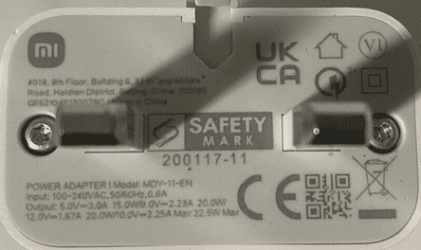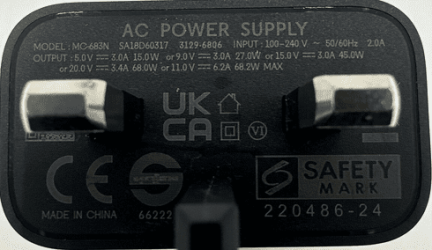Not Windows 11 related but I hope experts on here can help. I am ignorant regarding how electric devices draw power from chargers and I don’t want to damage my devices hence my query.
We have two smartphones. A Xiaomi model with a charger (22.5W maximum) and a Motorola with a charger (68.2W maximum). Both chargers and phones have USB-C 2.0 connection.
To save space and reduce cable clutter I was hoping to use only the Motorola charger for both phones in the hope that the device will only draw charge at a rate that it demands instead of the charger pushing more charge than the phone can take.
I see that charger output has several V x A output ‘modes’ as shown on photos. The Xiaomi charger has four modes and the Motorola charger has 5 modes but the two chargers only have the 5V 3A output mode in common.
Xiaomi charger supports wattage outputs of 5V 3A ¦ 9V 2.3A ¦ 12V 1.67A ¦ 10V 2.25A so maximum output is 22.5W
Motorola charger supports wattage outputs of 5V 3A ¦ 9V 3.0A ¦ 15V 3.0A ¦ 20V 3.4A ¦ 11V 6.2A so maximum output is 68.2W.
Question 1: Does this mean I can safely use the Motorola charger with the Xiaomi phone and it will auto-select the 5V 3A (15W) mode as the only compatible option?
Question 2: If the answer is ‘Yes’ then am I right that the only downside of a 15W output is a slower charge than using the 20W Xiaomi charger could deliver?
If it is not safe to do this then I am able to keep both chargers. It is just a preference if I could manage with just one charger for both phones.


We have two smartphones. A Xiaomi model with a charger (22.5W maximum) and a Motorola with a charger (68.2W maximum). Both chargers and phones have USB-C 2.0 connection.
To save space and reduce cable clutter I was hoping to use only the Motorola charger for both phones in the hope that the device will only draw charge at a rate that it demands instead of the charger pushing more charge than the phone can take.
I see that charger output has several V x A output ‘modes’ as shown on photos. The Xiaomi charger has four modes and the Motorola charger has 5 modes but the two chargers only have the 5V 3A output mode in common.
Xiaomi charger supports wattage outputs of 5V 3A ¦ 9V 2.3A ¦ 12V 1.67A ¦ 10V 2.25A so maximum output is 22.5W
Motorola charger supports wattage outputs of 5V 3A ¦ 9V 3.0A ¦ 15V 3.0A ¦ 20V 3.4A ¦ 11V 6.2A so maximum output is 68.2W.
Question 1: Does this mean I can safely use the Motorola charger with the Xiaomi phone and it will auto-select the 5V 3A (15W) mode as the only compatible option?
Question 2: If the answer is ‘Yes’ then am I right that the only downside of a 15W output is a slower charge than using the 20W Xiaomi charger could deliver?
If it is not safe to do this then I am able to keep both chargers. It is just a preference if I could manage with just one charger for both phones.


My Computers
System One System Two
-
- OS
- Windows 11 Pro
- Computer type
- PC/Desktop
- Manufacturer/Model
- HP EliteDesk 705 G5
- CPU
- AMD Ryzen 5 Pro 3400GE
- Memory
- 8GB DDR4 SDRAM
- Graphics Card(s)
- Integrated AMD Radeon Vega 11
- Hard Drives
- 256 GB PCIe NVMe M.2 SSD
-
- Operating System
- Windows 11 Home
- Computer type
- Laptop
- Manufacturer/Model
- DELL Inspiron 15-3576
- CPU
- Intel Core i5-8250U
- Memory
- 8 GB DDR4 - 2400 SODIMM
- Graphics card(s)
- Intel UHD Graphics 620
- Hard Drives
- 256GB SK Hynix SC311 SATA SSD





